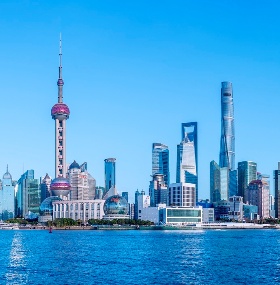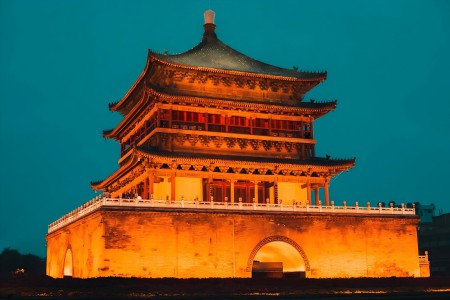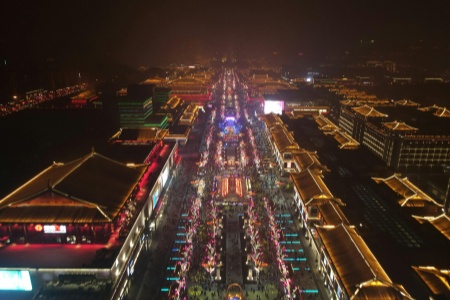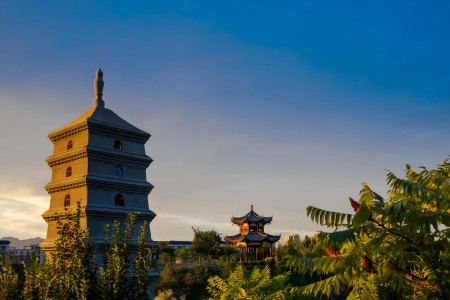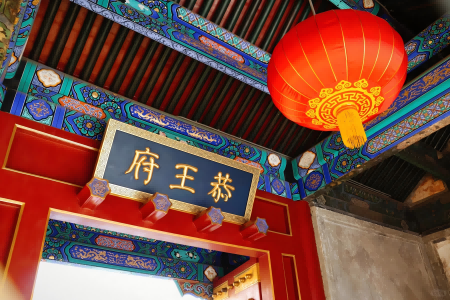Day 1: The Ancient Capital Xi'an – First Stop: Bell Tower
Today, we arrived in the ancient capital, Xi'an.Our first stop was the renowned Bell Tower. The Bell Tower stands tall, grand, and solemn, with every brick and tile seeming to tell a story of millennia past, echoing the bustling prosperity of its time.
After landing and following the crowd, we quickly reached the subway entrance.
Day 2: Bell Tower, Drum Tower, Muslim Quarter, Giant Wild Goose Pagoda, Yongxingfang
We planned for a grand feast and booked a hotel near the Giant Wild Goose Pagoda subway station. This location made it convenient to visit the Giant Wild Goose Pagoda, Da Ci'en Temple, the Shaanxi History Museum, and the Great Tang All Day Mall. The famous restaurant, "Defachang," is also nearby."Defachang" refers to a time-honored restaurant in Xi'an known for its classic Shaanxi cuisine and unique flavors. With a rich history and deep cultural heritage, it's a favorite among locals and tourists for authentic Shaanxi dishes.
Defachang's menu not only boasts unique flavors but also reflects Shaanxi's culinary traditions and craftsmanship. From classic dishes like roujiamo (meat sandwich) and yangrou paomo (lamb soup with flatbread) to other local specialties, the restaurant delivers unforgettable flavors.
1. Yongxingfang
Located on the eastern side of Xi'an's city wall, Yongxingfang lies inside Zhongshan Gate and was historically one of the 108 residential wards during the Tang Dynasty, once serving as the residence of the Tang Dynasty's Chancellor Wei Zheng. In 2007, as part of Xi'an's "Imperial City Revival Plan," Yongxingfang was reconstructed into the country's first cultural street themed around "intangible heritage cuisine," adding a unique boutique district to the ancient city.
Spanning 15 mu (about 2.5 acres), Yongxingfang features an ancient-style architecture cluster with pavilions, courtyards, and green spaces, showcasing the traditional street-block structure and lifestyle of ancient Chang'an. The design draws heavily on the cultural essence of the city walls, harmonizing history and humanity.
Visitors can enjoy a wide array of Shaanxi specialty foods here, such as "Smash Bowl Wine," Jiangmi La Rou Cake, handmade Ga Ba from Fuping, Lao Tongguan Roujiamo, and Lintong Persimmon Cakes. Alongside the culinary delights, traditional performances and craft demonstrations, such as puppetry, Guanzhong-style ritual bread-making, and woodblock prints, add to the immersive cultural experience.
Day 3: Shaanxi History Museum (Reservation Required)
The Shaanxi History Museum is not just a venue showcasing Shaanxi's historical richness but also a window for domestic and international visitors to understand and experience Chinese civilization. For History and Culture enthusiasts, this museum is a must-visit.
1. Reservation Tips:
● Follow the "Shaanxi History Museum" official WeChat account to reserve tickets, usually three days in advance. Visitors are allowed to enter one hour before their booked time slot.
2. Tickets and Admission:
Although admission is free, reservations are mandatory. Tickets can be booked through the museum's official WeChat account, with release times at 10:00, 11:00, 18:00, and 19:00 daily.The museum, China's first large-scale modern national museum, opened in 1991 and houses over 1.7 million artifacts, including 762 first-grade cultural relics and 18 nationally treasured items.
3. Opening Hours:
● Peak Season (March 15–November 14): 8:30–18:00 (last entry at 16:30)
● Off-Season (November 15–March 14): 9:00–17:30 (last entry at 16:00)
Closed on Mondays, except during national holidays.
Day 4: Xi'an City Wall & Hanguang Gate Relic Museum
The Xi'an City Wall, a remarkable representation of ancient Chinese fortifications, embodies deep historical and cultural heritage. Built during the Sui Dynasty and later expanded in the Ming Dynasty, it stands as one of China's best-preserved city walls.The wall features four main gates: Changle Gate, Anding Gate, Yongning Gate, and Anyuan Gate, each equipped with military defense facilities like arrow towers and watchtowers, showcasing ancient strategic ingenuity.
Walking or cycling along the wall offers a chance to appreciate the city's history and modernity simultaneously. The city wall also hosts cultural events such as international marathons and Festivals/index.html'>Lantern Festivals, enriching visitors' experiences.
The protective moat surrounding the wall has also been rejuvenated, with water conservation and landscaping efforts turning it into a scenic spot for leisure and recreation.
Day 5: Terracotta Army Museum, Huaqing Palace, and "Song of Everlasting Sorrow" Performance
1. Terracotta Army Museum Tips:
● Take a direct bus (about 30 RMB/person) from the Vienna Hotel parking lot near the Giant Wild Goose Pagoda D Exit. The trip takes about an hour.
● Official guided tours are available for 60 RMB/person and require cash. Avoid unofficial guides outside the ticket gates.
The museum, comprising The Terracotta Army and the Emperor Qinshihuang's Mausoleum Park, combines education, research, and tourism. As a UNESCO World Heritage Site, it features archaeological finds like bronze chariots, clay soldiers, and intricate grave goods, offering insights into China's ancient artistry and power.
2. Huaqing Palace:
Famous for its hot springs and historic events like the Xi'an Incident, this site also hosts the grand outdoor performance "Song of Everlasting Sorrow." The show portrays the love story of Emperor Xuanzong and Yang Guifei through music, dance, and scenic visuals, creating a captivating cultural experience.Tickets for the show should be booked in advance online via platforms like Ctrip or Meituan. Visitors are advised to arrive at least 30 minutes before the show for security checks and seating.
This extraordinary performance, inspired by Bai Juyi's narrative poem, blends Tang-era aesthetics with modern artistry, immersing the audience in the poignant love story and the grandeur of Tang culture.
Day 6: Daci'en Temple and Climbing the Giant Wild Goose Pagoda
1. Daci'en Temple
Admission tickets are required, and entry is validated through ID.
Located in the Jinchang Ward of Tang Chang’an City (now in the southern part of Xi'an, Shaanxi Province), Daci'en Temple is the birthplace of the Consciousness-Only School (also known as the Yogācāra, Faxiang, or Ci'en School), one of the eight major schools of Chinese Buddhism. It is also one of the three major translation sites of Tang Chang’an. This temple, with a history of over 1,350 years, was the most renowned and magnificent Buddhist temple within the Tang capital. It was constructed by imperial decree of the Tang royal family. In the 22nd year of the Zhenguan reign (648 CE), Crown Prince Li Zhi built the temple to honor his late mother, Empress Wende (Consort Zhangsun).
Xuanzang, the renowned monk, once presided over temple affairs here and led the translation of Buddhist scriptures, founding the Consciousness-Only School. This made Daci'en Temple an incredibly significant site in the history of Chinese Buddhism.
2. Giant Wild Goose Pagoda
The Giant Wild Goose Pagoda is an iconic structure within Daci'en Temple, located in its western courtyard. It was originally constructed under the supervision of Xuanzang to house the Buddhist sutras and statues he brought back from India. The pagoda was initially five stories tall, later extended to nine, and underwent several reconstructions before settling into its current seven-story form. Today, it stands 64.517 meters tall, with a base measuring 25.5 meters on each side.
As the earliest and largest surviving Tang Dynasty square brick pagoda, the Giant Wild Goose Pagoda is a testament to how Indian Buddhist architectural forms were integrated into Chinese culture as Buddhism spread to the Central Plains.
The seven-story design of the pagoda holds deep roots in Buddhist symbolism.
A common Buddhist saying, "Saving one life is better than building a seven-story pagoda," refers to the merit of a seven-tiered tower. In Buddhist tradition, the number seven carries profound significance. For example, it is said that when the Buddha was born, he took seven steps, with lotus flowers blooming at each step. This gave rise to phrases like “the Buddha's seven steps” and “seven steps to enlightenment.”
The Giant Wild Goose Pagoda, as a cultural treasure of the Tang Dynasty, symbolizes the ancient Silk Road and the deep history of Sino-Indian cultural exchanges. Built by Xuanzang to preserve the scriptures and statues he brought back from India, the pagoda is not only a religious structure but also a cultural repository. The seven-story design reflects these rich cultural and religious contexts.
Originally constructed as a ten-story structure, the pagoda suffered significant damage over centuries due to erosion and structural challenges. Three collapsed levels were removed, leaving the current seven-story configuration. This historical event ultimately shaped the pagoda as it appears today.
Upon leaving Daci'en Temple, I took this photo during a quiet moment. It depicts the statue of Xuanzang, embodying his ideals and determination as he overcame countless challenges to bring Buddhist scriptures to China.
3. Xuanzang
Xuanzang, a renowned monk of the Tang Dynasty, was the founder of the Consciousness-Only School, a translator of Buddhist scriptures, and an extraordinary traveler. At the age of 13, he became a monk, immersing himself in Buddhist texts. He later studied under the abbot Jie Xian, eventually becoming the deputy lecturer of the monastery.
During the Zhenguan reign, he embarked on his journey westward to India, seeking Buddhist scriptures and teachings. After enduring immense hardships, he successfully returned with a vast collection of Buddhist relics, statues, and scriptures.
Back in China, with the support of Emperor Taizong, Xuanzang established a translation center at Daci'en Temple in Chang’an. Together with his disciples, he focused on translating the Buddhist texts he had brought back. His translation work was monumental, producing 75 works in 1,355 volumes, including The Great Prajñāpāramitā Sutra, The Heart Sutra, The Sandhinirmocana Sutra, Yogācārabhūmi Śāstra, and Cheng Weishi Lun. These translations had a profound and lasting impact on the development of Buddhism in China.
Xuanzang not only dedicated himself to translating Buddhist scriptures but also trained numerous Buddhist scholars, including Japanese monk Dōshō and Korean monk Woncheuk, who later became significant figures in their respective countries’ Buddhist traditions. Xuanzang’s travels across India and his teachings left a lasting legacy, spreading his influence to Japan, Korea, and beyond, making him a shared treasure of Asian and global heritage.
Xuanzang's achievements in bringing Buddhist scriptures to China and fostering cultural exchanges between China and India have made him an exceptional ambassador of Sino-Indian cultural interaction. Revered as “the backbone of the Chinese nation” and “a messenger of world peace,” Xuanzang’s patriotism and dedication to preserving Buddhism will forever be remembered.
Related Posts
Create Your Customized Trip
Take about 2 minutes to fill the form to tell us how you like to travel, and get a reply within 1 working day.

